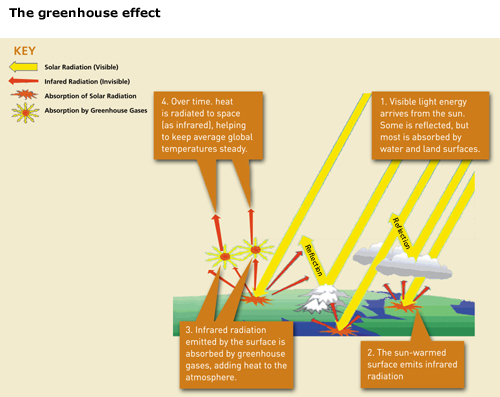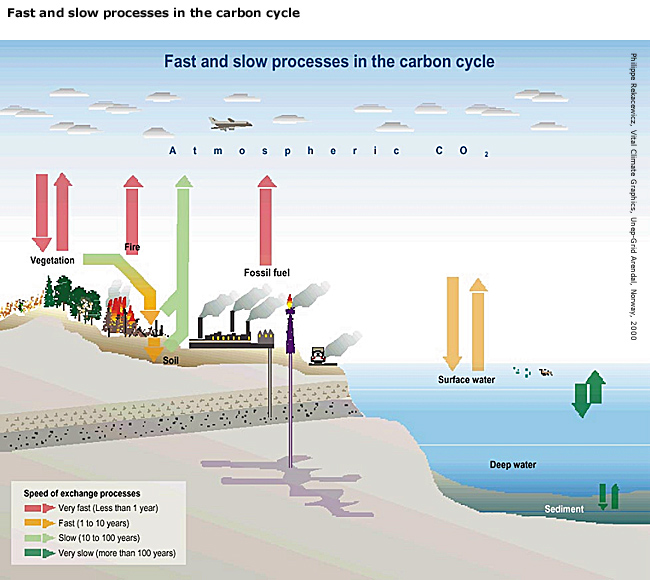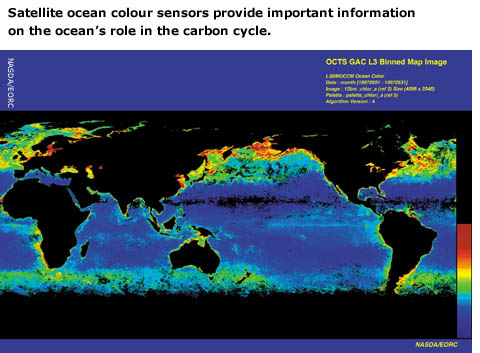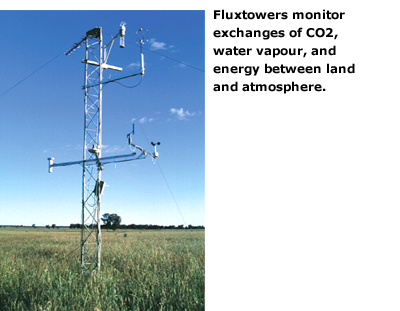 |
|||||
|
Counting on Carbon A global concern In New York on 9th May 1992, the UN Framework Convention on Climate Change (UNFCCC) was adopted; to date, the most significant global legal framework for international action to address climate change. By the start of 2002, 186 countries and the European Community had become Parties to the Convention. The
ultimate objective of this Convention is to achieve stabilisation
of greenhouse gas concentrations in the atmosphere at a level that
would prevent dangerous anthropogenic The UNFCCC was strengthened at a meeting of the Conference of the Parties (COP) to the Convention in December 1997, where a legal instrument – named The Kyoto Protocol – was adopted. The Protocol subjects industrialised countries to legally-binding targets to limit their greenhouse gas emissions. These targets add up to a total reduction of 5% in greenhouse gas emissions from 1990 levels, for the five-year period 2008-2012. By the start of 2002, 84 countries had signed; in order to enter into force, the Protocol will have to be ratified by 55 Parties to the Convention, including enough major industrialised Parties to account for at least 55% of the total carbon dioxide emissions by industrialised countries in 1990.
National commitments under the Kyoto Protocol were not offered lightly. The necessary reductions in greenhouse gas emissions will require changes in the way in which countries generate energy, provide transportation, and manage land use – issues which are all fundamental to future economic development. However, the necessary impetus to meet these challenges is the alarming realisation, based on the best available scientific assessment, that human activities are already affecting the Earth’s climate, and that the emission of greenhouse gases is a primary cause. The term ‘climate change’ usually refers to changes in the climate system, notably a global warming trend caused by emissions of greenhouse gases that create a ‘human-induced greenhouse effect.’ The most important of these gases is carbon dioxide (CO2), which comes mainly from the burning of fossil fuels such as oil, gasoline, natural gas and coal. Other important greenhouse gases include methane (CH4), nitrous oxide (N2O), ozone (O3), and chlorofluorocarbons (CFCs). As noted in Part I of this document1:
The International Response The relevant international communities are collaborating on an unprecedented global scale in order to observe, model, and understand the underlying Earth system processes and to implement policy measures to avert the worst effects of the ‘business as usual’ scenario. The main policy initiative is the Kyoto Protocol. The Kyoto Protocol sets limits on the emission of six main greenhouse gases:
Some specified activities in the land-use change and forestry sector (namely, afforestation, deforestation and reforestation) that emit or remove carbon dioxide from the atmosphere are also covered. All changes in emissions, and in removals by so-called ‘sinks’ (absorbers), are considered equivalent for accounting purposes The Protocol also establishes three innovative ‘mechanisms’, known as ‘joint implementation’, ‘emissions trading’ and the ‘clean development mechanism’, which are designed to help Parties reduce the costs of meeting their emissions targets by achieving or acquiring emission reductions more cheaply in other countries than at home. The clean development mechanism also aims to assist developing countries to achieve sustainable development by promoting environmentally-friendly investment in their economies from industrialised country governments and businesses.
The Global Carbon Cycle Since the dominant influence on future greenhouse gas trends is widely agreed to be the emission of CO2 from fossil fuel burning, an improved understanding of the global carbon cycle has become a policy imperative for the forthcoming decades, both globally and for individual countries. The global carbon cycle connects the three major components of the Earth system: the atmosphere, oceans, and land. In each domain, large pools of readily exchangeable carbon are stored in various compartments (‘pools’ or ‘sinks’ and ‘sources’). Large amounts of carbon (‘fluxes’) are transferred between the sinks and sources over various time periods, from daily to annual and much longer. Although some of the fluxes are very large, the net change over a given time period need not be. For many centuries prior to the industrial revolution the carbon sinks and sources were more or less in equilibrium, and the net transfer was close to zero for the planet as a whole. The major changes have occurred following the development of agriculture and industry, with the accelerated transfer from the geological (fossil fuels) and terrestrial pools to the atmosphere. Because of the connections among pools, the increased atmospheric carbon concentration affects the other connected pools in oceans and on land. The Kyoto Protocol recognises the role of terrestrial systems as carbon sinks and sources, and it provides a basis for developing future ‘emission trading arrangements’ that involve forests and potentially other ecosystems. Understanding of the pathways through which the anthropogenic CO2 is absorbed from the atmosphere and into ecosystems (thus offsetting a portion of the anthropogenic emissions) is fragmentary and incomplete. These factors and dependencies make the quantification and study of the carbon cycle very challenging to model, observe, and predict.
Observing the carbon cycle The UNFCCC and the Kyoto Protocol represent the first attempt by mankind, acting collaboratively across the world, to manage, at least partly, a global element cycle of the Earth system – the global carbon cycle. This challenge requires the support of a coordinated set of international activities – scientific research (including modelling), observation, and assessment. Assessment is perhaps the most advanced, with the pioneering work of the IPCC providing the scientific assessment required for the policy action. In terms of scientific research, the International Geosphere-Biosphere Programme (IGBP) has recently joined forces with the International Human Dimensions Programme on Global Environmental Change (IHDP) and the World Climate Research Programme (WCRP) to build an international framework for integrated research on the carbon cycle (a project called Carbon 21). A key element of international carbon activities – an integrated strategy for the observation of the global carbon cycle, including the land, oceans, atmosphere compartments of the cycle, is being coordinated by the IGOS Partnership, within the Integrated Global Carbon Observations (IGCO) Theme (see annex B for more on IGOS Themes).
A broad range of observations of important atmospheric, oceanic, and terrestrial parameters are required to: support future policy-making with evidence of trends; monitor the legal commitments undertaken within the Kyoto Protocol or future treaties; improve scientific understanding of the underlying processes. The same observations are important requirements for sustainable development and resource management. The IGCO Theme will build on a number of carbon cycle observation initiatives at the Earth’s surface which are underway or planned, including:
The role of Earth observation satellites Data from Earth observation satellites provide the only global, synoptic view of key measures of the carbon cycle, and form an essential and central part of the envisaged integrated observation strategy planned within IGCO. The major applications include:
The most challenging aspect of observing the carbon cycle from space is the development of instruments for monitoring total column CO2 concentration with complete coverage. Future challenges Future challenges relating to the global carbon cycle include:
Future plans for next generation Earth observation satellites include:
The necessary coordination of the relevant satellite missions will be undertaken by CEOS including through their participation in the IGCO Theme. Part III of this document summarises the various plans of the world’s space agencies. |
||
|
||




